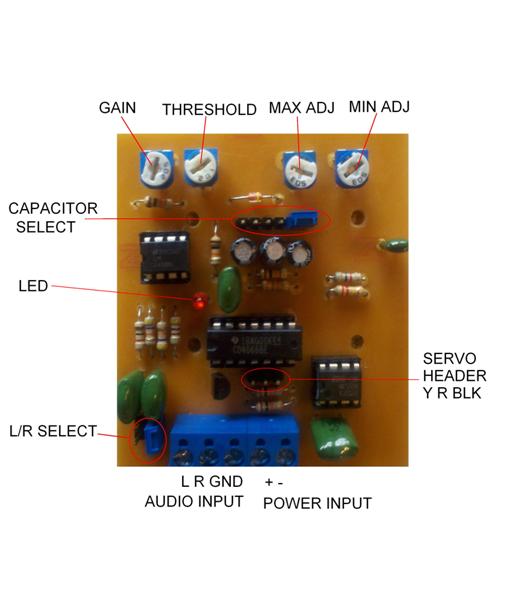Simple Sound to Servo
The Simple sound to servo is an inexpensive controller based on the Scary Terry sound to servo circuit found here http://www.scary-terry.com/audioservo/audioservo.htm This circuit takes an audio source such as an MP3 player and outputs a signal to a hobby servo to move the jaw to the sound on talking props.
Gain: The gain adjustment is used to control the gain of the amplifier to match the controller to your source audio
Threshold: The threshold adjustment is used to calibrate the circuit and set the point of sound or no sound
Max Adj: The max adjust is used to set the maximum servo position when sound is present. You can think of this like a high limit switch
Min Adj: The min adjust is used to set the minimum servo position when sound is not present. You can think of this like a low limit switch.
Capacitor Select: There are 3 capacitors of different values to chose from. The higher the value of the capacitor the more smooth the jaw will move. If you want a more jerky action enable a lower value capacitor or no capacitor at all. The capacitors are arranged lowest to highest value from left to right. Capacitors are enabled by placing a shunt on the jumper directly above each capacitor.
LED: The LED lights up when sound is present and is used to aid in setting the threshold adjustment
L/R Select: If you want the board to "Listen" only to the left or right channel of audio install a shunt on either the left or right jumper. If you want it to "listen" to both channels install shunts on both jumpers.
Audio input: This is where you connect stereo audio to the board. anything from line level to low level speaker should be OK
Power input: 4.7-6 VDC is connected here. The current required will depend largely on the servo you are using. This circuit draws very little current check the specs your servo for current requirements
Servo Header: This is where your servo will connect to the board. Pin#1(yellow) goes to the left when connecting the servo
Setup
1 Turn on the power and remove all audio source. This can be done by removing the L/R select shunts
2 Turn the threshold adjustment clockwise until the circuit trips(the LED will light and the servo will move to the open position)
3 Adjust the MAX adjust to your desired full open position.
4 Slowly turn the threshold adjustment counter-clockwise until the circuit resets(LED will turn off and servo will move to the closed position)
5 Adjust the Min adjustment to your desired full closed position.
6 Add your audio source and adjust the gain as needed to make the circuit trip and reset with the audio
Description of operation
From the Scary Terry website
"As long as there is sound present, the servo will drive to its "max" position. If the sound is short in duration, the servo will not have time to drive to "max" but will drive part way and return to "min" position. While this method of moving a mouth is not perfect, it's pretty good and I'm very happy with the effect. It's important to remember that any sound will drive the servo, voice, music or noise, so if you're trying to make a Bucky mouth move to a voice track, you shouldn't have music in the background of that particular track. There is a way to include music or other sounds and still have the appropriate jaw movement. Jeff Stevens came up with a solution and I include his email at the bottom of this page"
Jeff Stevens solution
"Dear Scary-Terry, I am writing you about a new method for using your audio-servo driver. Here’s how you do it. First, you record your sounds on a two channel cd and player. On one of the channels have the voice and all other audio effects that you want people to hear, such as music or thunder etc. On the other channel, whether it is the left or right it doesn’t matter, you record the sounds that you want to drive the audio-servo driver. You connect this channel to the audio driver. You then use a y-splitter to take the first channel, the one you want people to hear, and connect it to both channels on the amplifier or amplified speakers. You now have the ability to have music without it activating the skull. The effect sounds stereo because it is coming out of two speakers, but both are playing the same thing. That is the only disadvantage. Let me know what you think. -Jeff Stevens"
Schematic
Here is a schematic diagram in pdf format File:Simple Sound to Servo sch.pdf
Board
Currently this is a home etch only circuit board. You can download the needed files to etch your own circuit board from the File Library

